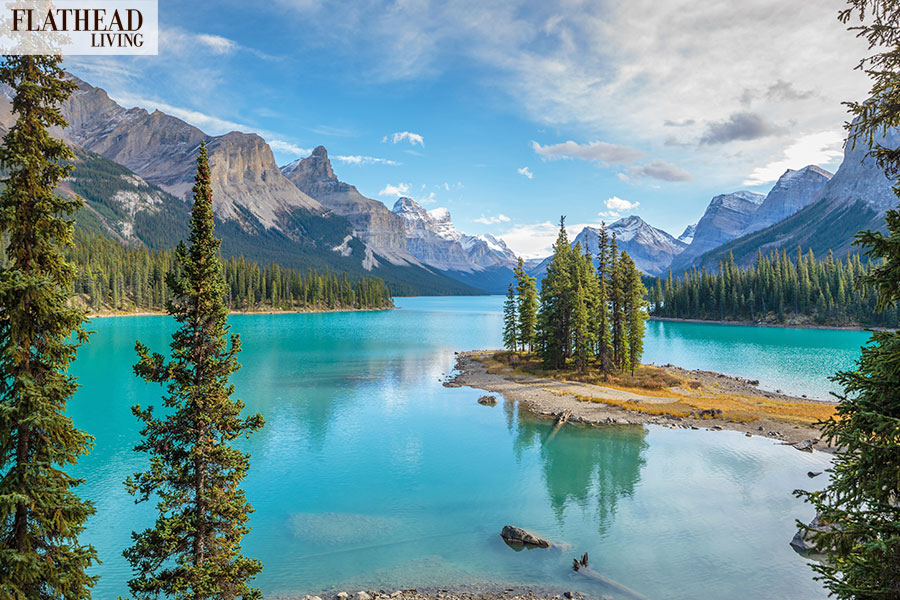With summer on the horizon, it’s time to iron out vacation plans, whether it’s a quick weekend getaway or a weeklong escape.
This year, Canada has an enticing offer.
Our neighbors to the north are celebrating their country’s 150th birthday, and, as a gift for everyone, admission is free to all national historic sites, national marine conservation areas and national parks, including Banff, Jasper and Waterton Lakes. Yes, even Americans get free entry.
Parks Canada, the agency that manages the country’s natural treasures as the National Park Service does in the U.S., is inviting everyone to explore its history and outdoor amenities by ordering a Discovery Pass, which will provide unlimited free access all year. The passes, which will cover a group traveling together, can be ordered online at www.pc.gc.ca. Camping fees and other services, such as tours and rentals, are not included with the free pass.
Why visit Canada’s 47 national parks when the U.S. is home to its own extensive lineup of thrilling landscapes?
For starters, even though Canada’s national parks may not span as many acres as America’s, these iconic gems are undoubtedly world-class attractions: From the breathtaking views in Jasper, to the Edenic scenery in Banff, to the rugged peaks in Kootenay, these cherished sites rival any outdoor destination on the continent.
For residents in Northwest Montana, several national parks across Western Canada are less than a day’s drive away, making it possible for a short trek or a full vacation without long travel requirements.
Need more motivation? The exchange rate favors the U.S. dollar. In late February, $1 U.S. was worth $1.32 Canadian, meaning $100 is worth $132 up north. During the U.S. recession, Canadians spent a considerable amount of time and money in Northwest Montana, helping the local economy endure a difficult period. Now, as Alberta faces economic woes, it’s our turn to give our neighbors a boost.
The summer months are sure to be busy, just as they are in U.S. national parks, so plan ahead. And don’t forget your passport.
______________________________
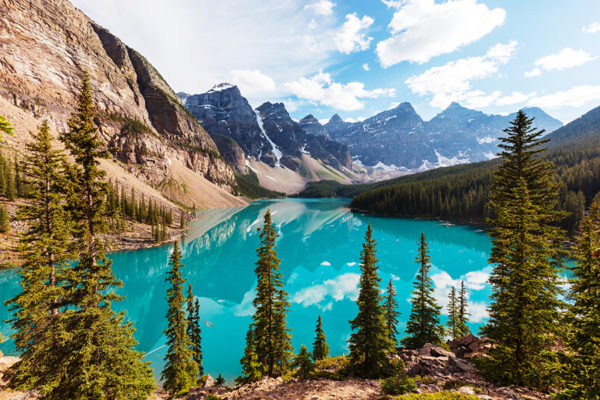
Banff National Park
Distance from Kalispell: 300 miles (5.5 hours)
Canada’s first national park is truly a first-class destination and one of the country’s most popular attractions. Nestled on the eastern edges of Alberta’s Rocky Mountains, Banff is an idyllic getaway spanning 1.64 million acres defined by ancient glaciers, dense forests and towering peaks.
Open year-round, the town of Banff is a good hub from which to plan a full vacation’s worth of activities, such as hiking, cycling, wildlife viewing and paddling. The town itself has enough activities to deserve its own day of adventuring with plenty of retail shops, restaurants and a 27-hole championship golf course.
Want to indulge in the magnificence of hot mineral water? Check out the world-famous Banff Hot Springs just south of town. These hot springs should be experienced early and often. Soak it up this spring through May 18.
Summertime ushers in a flood of visitors, so planning your trip in advance is recommended.
A must-see attraction is the majestic Lake Minnewanka, about 20 minutes north of town. Known by the Stoney-Nakoda First Nations as “the Lake of the Water Spirits,” it’s a perfect place to relax and enjoy the breathtaking beauty of the surrounding geography.
Grab a bike and enjoy the Banff Legacy Trail, a 13.8-mile paved pathway that travels from the Banff Park East Gate to the Bow Valley Parkway, offering unforgettable views of the park. The trail was built in honor of Banff National Park’s 125th anniversary and embodies the park’s values by encouraging visitors to explore the landscape in an environmentally friendly way. The trail is best enjoyed from mid-April through October.
One of the best places to view wildlife and birds, the Vermillion Lakes are just outside of town and have a scenic trail around the wetlands area.
Just up the road from Banff, the village of Lake Louise is another landmark worthy of a full day. During winter, Lake Louise is home to one of the largest ski resorts in North America. The small town is near its namesake lake, which is a must-see attraction. From Lake Louise, take a short trip to Moraine Lake to witness the famous blue-green waters surrounded by the towering Valley of the Ten Peaks.
Local Tip: Stay in an oTENTik
These overnight lodging units at Two Jack Lake are exclusive to Parks Canada. A cross between an A-frame cabin and a prospector tent mounted on a raised wooden floor, these fun, family units offer two queen-sized beds and one double-sized bed. There are 10 oTENTiks — 19 by 24 feet wide and large enough for up to six people — available to reserve online from late May through mid-September. All you need to bring is bedding and/or sleeping bags, blankets and pillows. Kitchen supplies, such as pots, pans and cutlery, are available to rent.
Check it Out: Cave and Basin National Historic Site
Located near downtown Banff, the underground cave and natural hot springs are the birthplace of the national park. Guided tours are offered to showcase the bubbling mineral waters and architecture that inspired the national parks in Canada. The history dates back to 1883, when three railway workers stumbled upon the site and turned it into a well-known refuge. Two years later, Canada’s first Prime Minister, John A. Macdonald, made an unprecedented decision and set aside the Cave and Basin hot springs and 26 kilometers of land (16 square miles) as a small protected reserve, effectively creating the country’s first protected national park.
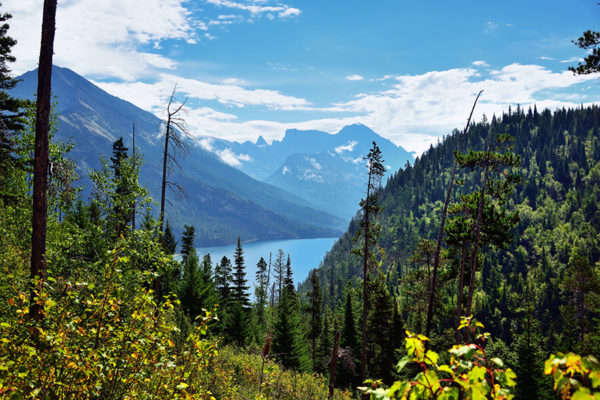
Glacier National Park
Distance from Kalispell: 314 miles (6 hours)
You thought we had the only Glacier National Park? Formed in 1886, Glacier National Park in Canada is similar in many ways to its twin in Northwest Montana with high alpine terrain overlooking deep, sweeping valleys and dense forests. The park encompasses 521 square miles west of Kootenay and Yoho national parks near the town of Golden. It has one of the country’s largest cave systems, including the 3.7-mile long Deutchmann Caves.
This year-round paradise is also home to Rogers Pass, a high mountain route maneuvering through the Selkirk Mountains and providing passage for the Canadian Pacific Railway and the Trans-Canada Highway. It was discovered in 1881 as a key pathway through the wilderness and is now a National Historic Site in Canada. The Rogers Pass Discovery Centre, which includes a museum, is a great destination to learn about the rich history of the area and surrounding scenery.
Perhaps the most noteworthy aspect of Glacier Park is its propensity to attract deep powder. The park straddles the Selkirk Range, which is known for its legendary steep lines and snow stashes. Backcountry ski touring is a popular pastime here, and visitors have a large playground of thrilling terrain, including glades, alpine bowls and icefields with descents spanning as far as 4,900 feet.
West of Rogers Pass and south of Mount Sir Donald, the Illecillewaet Glacier is easily accessible by road and is one of the most studied glaciers in North America. View this 3.41-square-mile ancient glacier before it’s gone, as its retreat over the last century has been well-documented.
Just west of Glacier Park is Mount Revelstoke National Park, another small but worthwhile destination. The Meadows in the Sky Parkway is a spectacular site with dozens of hiking and walking trails that reward visitors with subalpine meadows and an awe-inspiring view of Mount Revelstoke. If you’re a skier, you’ll want to hit up Revelstoke Mountain Resort, hailed as one of the most exciting ski resorts in North America with the most vertical.
Local Tip: Bike in Revelstoke
Revelstoke is home to one of the best trail systems in the region with a vast cross-country network, shuttle-accessed downhill sections and easy access to alpine paths. Frisby Ridge and Keystone are two of the best trails. Bring your bike or rent one at one of the many shops. There is even a heli-skiing business that in summertime drops bikers atop Mount Cartier trail, which offers 7,000 feet of prime singletrack.
Check it Out: Hemlock Grove Trail
Experience the world’s only non-coastal cedar hemlock rainforest, hidden on the western boundary of Glacier Park. This amazing jewel features a boardwalk exploring the ancient stand of trees, which rise into the clouds in awe-inspiring fashion.
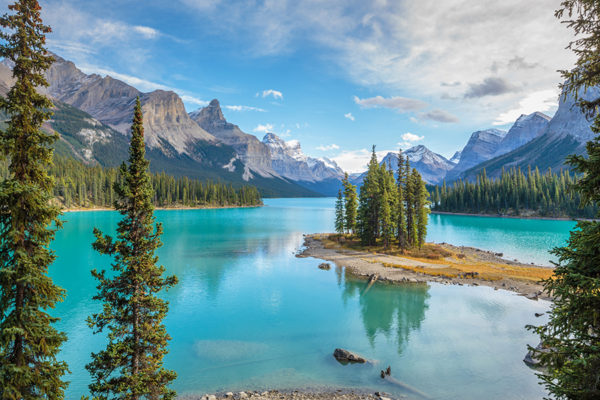
Jasper National Park
Distance from Kalispell: 440 miles (8 hours)
It’s a bit of a trek from the Flathead Valley, but the journey will be well worth your time. Encompassing 2.77 million acres of Alberta’s wild, hilly interior, this is the largest national park in the Canadian Rockies and one of the most intact ecosystems on the planet. It was established 110 years ago and remains a rugged landscape, home to sky-high peaks and some of the largest populations of grizzly bear, moose and elk on the continent. This park has it all: glaciers, grand mountain valleys, lush forests and winding rivers with every activity you can imagine, including rock climbing, horseback riding, hiking and rafting. Good luck fitting everything into one trip.
The diversity of wildlife — nearly 70 species of mammals — led Jasper to be named a UNESCO World Heritage Site. Wildlife viewing is abundant any time of year.
To launch your adventures, drive north along Highway 93 to the town of Jasper in the heart of the park and begin your sightseeing extravaganza. Like most other national parks, Jasper is open year-round but is most weather-friendly during the summer and early fall months. From town you can rent boats, paddleboards or bikes to enjoy an afternoon adventuring on the nearby trails, including the relatively easy trek to Pyramid Lake.
Overall, Jasper offers 620 miles of designated trails. There is an abundance of overnight options, including private lodges, hostels and public campgrounds, but sites fill up quickly during summer, so plan ahead. There are also licensed commercial services, including three backcountry lodges and four alpine huts managed by the Alpine Club of Canada.
For a fun family activity, the park’s newly established Easy Trail System yields 12 miles of bike-friendly, multi-use pathways that wind throughout town.
One of the most spectacular areas is Maligne Lake, the largest natural lake in the Canadian Rockies. Surrounded by snow-capped mountains, the 13.6-mile long body of water extends to the melt-water channels of Coronet Glacier. One of the most popular images in the Canadian Rockies is the scene of Spirit Island in the middle of the lake, particularly at sunset or sunrise.
Jasper’s dark skies are magical as well. This is the second largest dark sky preserve in the world, meaning the nighttime views are essentially unrivaled. The best places to check out the night sky are Pyramid Island, Maligne Lake, Old Fort Point and the base of Athabasca Glacier. The best time of year to catch the starry skies is October, when the annual Jasper Dark Sky Festival takes place.
Local Tip: Plan Plenty of Time
This is easier said than done, but you don’t want to rush your way through vacation, hurrying from one eye-opening adventure to the next. Especially when you’re visiting a place like Jasper, you want to be able to soak in as much of the unique experience as possible without the distraction of a deadline. For inspiration, while you’re in Jasper, check out Edith Cavell and 93A, a breathtaking viewpoint that will etch itself in your mind for those days back home when you’re sitting at your desk, yearning for adventure.
Check it Out: Travel the Icefields Parkway
The same way Montanans delight in driving Glacier Park’s iconic Going-to-the-Sun Road, Canadians revel in traveling the route known as the Icefields Parkway. It’s truly a national treasure, and National Geographic has called it one of the 10 most scenic drives in the world. The road stretches 144 miles through the heart of the Canadian Rocky Mountain Parks World Heritage Site, from Banff north to Jasper. The journey passes vast wilderness landscapes, jagged peaks, mammoth glaciers and breathtaking valley views.
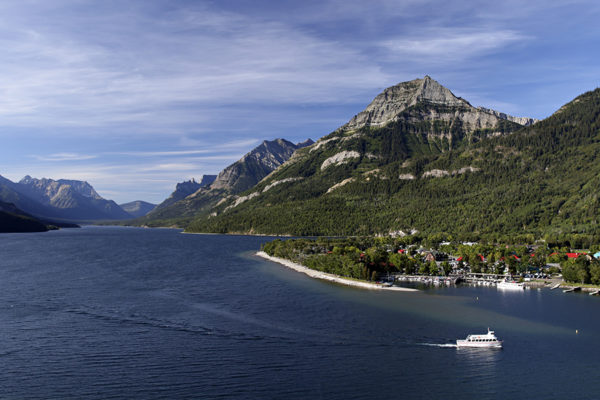
Waterton Lakes National Park
Distance from Kalispell: 174 miles (3.5 hours)
Northwest Montana has a unique relationship with this isolated corner of southwestern Alberta. Back in 1932, the U.S. and Canada created the world’s first International Peace Park by banding together Waterton Lakes National Park and Glacier National Park, and today the joint peace park remains a model of diplomacy and transboundary collaboration. The partner parks also share another quality: they boast amazing outdoor amenities.
Situated inside the boundary of the national park, the townsite of Waterton is a cozy community on the picturesque shores of Upper Waterton Lake. The small town is open year round but mostly comes to life in summer when tourists flock in droves to enjoy all the qualities of an ideal vacation — fine dining, colorful storefronts for shoppers and more than enough activities to fill your trip, including a golf course and boat rentals.
Parks Canada operates three campsites in the park with hook-ups for RVs. There are also several hotels and inns.
Any trip to Waterton should include a cruise on the M.V. International, the historic flagship that carries passengers across the emerald-green lake into the northern gateway of Montana’s Glacier Park at Goat Haunt, a seasonal port of entry. The classic boat was originally built in Kalispell and shipped in pieces to Waterton, where it began carrying passengers in 1927. Visitors can also rent bikes and scooters or enjoy horseback riding. The hiking opportunities are abundant, and Canadian park rangers lead several guided treks along the Lakeshore Trail, which is family friendly.
Another popular afternoon adventure involves ascending the mountain overlooking town and summiting Bear’s Hump, a short but strenuous climb that rewards anyone who’s successful. From this vantage point, you can see the spectacular panoramic views of the Waterton Valley, where the mountains meet the prairies. You can even see Mount Cleveland, the tallest peak in Glacier Park.
Local Tip: Spring Vacationing
Arguably, the most spectacular time of year to visit Waterton is springtime, when the mountains and meadows transform with the explosion of wildflowers. Locals annually celebrate the season at the Waterton Wildflower Festival, June 15-20, with guided hikes, photography workshops and field classes.
Check it Out: The Prince of Wales Hotel
Standing seven stories tall with a steeply pitched roof and a prominent presence at the head of the lake, “The Prince” remains a revered landmark and lodging destination. This year marks the hotel’s 90th birthday. Spending the night in one of the lodge’s 86 guest rooms is an unforgettable experience that harkens back to a bygone era. The staff all don royal tartans, or kilts, in homage to the hotel’s British namesake, Prince Edward. Even if you’re not staying the night, a visit inside “The Prince” is a can’t-miss experience.
